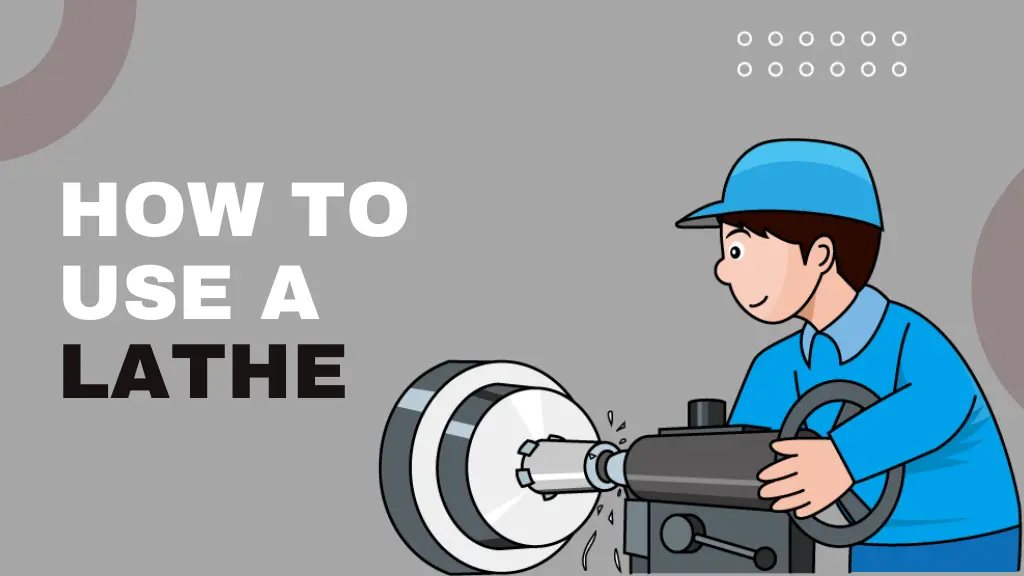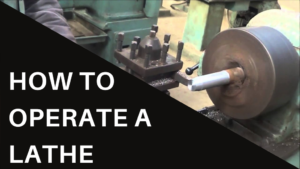Explore the world of lathes and discover the precision, versatility, and artistry behind this using a lathe-powerful machining tool. Learn how to use a lathe effectively for woodworking, metalworking, and crafting. Unlock your potential in the world of craftsmanship. Modern lathes offer adjustable rotating speeds and manual and automatic tool movement mechanisms.
What is a Lathe?

A lathe is a machine tool primarily used for shaping various materials, including metal and wood. It secures and rotates the workpiece while a cutting tool advances into the material, resulting in the desired shaping or cutting action.
Initially designed for cylindrical metal stock, lathes have evolved to handle tasks such as producing screw threads, creating tapered workpieces, drilling holes, adding knurled surfaces, and crafting crankshafts. Modern lathes offer adjustable rotating speeds and manual and automatic tool movement mechanisms.
Primary Steps To Using a Lathe
- Prepare the Lathe and align the cutting tool to suit your specific project requirements. Typically, small bench lathes are securely mounted on sturdy benches or pedestals.
- Secure your workpiece into the Lathes’ headstock using a device known as a “jaw chuck.”
- Most modern mini-lathes come equipped with a protective chuck guard. Install the guard, select the rotation direction, and power up the Lathe.
- Set the Lathe to a specific RPM (revolutions per minute), and always ensure you are wearing appropriate safety gear.
- Carefully advance your tool post toward the rotating workpiece, initiating a gentle pass.
- Adjust the carriage to position the cutting tool as needed.
- Different types of cutting tools are available for various machining operations. Gradually remove material from the mounted workpieces’ surface until you achieve your desired result.
- Be cautious when dealing with sharp cutters, lathe centers, and drills, as mishandling them can lead to accidents. Always handle these tools with care and precision.
- Once you’ve completed your initial pass, switch off the Lathe and assess your progress.
- After employing the necessary tools and completing the machining passes, your workpiece will have taken shape, whether it’s doorknobs, metal mallets, key rings, metal rings, threads, or other items.”
Different Methods of the Drilling Lathe

The following Methods are used for Drilling:
Center Drilling
Central Drilling has primary objectives:
- Center drilling aims to initiate holes precisely along the Lathe’s axis.
- Unlike regular drills, center drills are exceptionally rigid, short, and cut precisely at the point.
- This characteristic ensures that we start our hole precisely on the center axis, facilitating the natural alignment of subsequent tools.
Pilot Drilling
Pilot drilling has primary objectives:
- It helps maintain the straightness of the larger drill bit.
- It creates clearance for the chisel tip at the end of the larger drill. Adequate clearance is crucial because a large chisel tip can impede cutting.
- Clearing chips from the drill is essential.
- A practical way to achieve this is by retracting and re-engaging the tailstock, preserving the tailstock Ram’s settings.
Larger Size Drill
To create a larger hole,
- Secure the larger drill bit.
- Begin drilling approximately 0.5 millimeters shy of your final reamer size and reduce the Lathe’s speed by 60%.
- Gradually reach the final depth, and when complete, retract the drill by loosening the tailstock.
Reamer Drilling
- When using a reamer, remember never to run it backward, as this is a fundamental rule.
- Avoid attempting to unscrew it whenever possible, as this can damage the cutting edges.
How do you Sharpen Drill Bits Using a Lathe?
If you’re looking to sharpen drill bits using a metal lathe, this process typically involves using a grinding tool. You’ll need a drill bit and a piece of aluminum during the bit sharpening procedure. Before you begin, you must grasp some key terminology related to the drill bit.
Examine the drill bit from various angles, and you’ll notice certain edges. These edges are referred to as the back rake, which denotes the angle on the top surface of the bit. Back rakes can be categorized into positive, negative, and zero back rakes when observed from the side view.
Safety Tips for Using a Lathe
Safety Tips for Using a Lathe are as follow:
- Clothing Awareness:
- Avoid wearing full-sleeve dresses when operating the Lathe.
- Refrain from donning ties, aprons, or any loose-hanging clothing.
- Remove rings and wristwatches before starting work.
- Pause for Adjustments: Whenever adjustments are needed, always stop the Lathe before making any changes or modifications.
- Safe Chip Removal: Never use your hands to clear away chips and swarf. Instead, use pliers or a brush to remove debris safely.
- Spindle Speed Change: Wait until the Lathe comes to a complete stop before adjusting spindle speeds to prevent accidents.
- Eye Protection: Wear appropriate protective eyewear while operating the Lathe to shield your eyes from potential hazards.
- Chuck Key and Wrench Removal: Remove any wrenches or chuck keys from the machine before starting the Lathe.
- Handle Cutting Tools with Care: Be cautious when dealing with sharp cutters, centers, and drills, as mishandling them can lead to accidents. Always handle these tools with care and precision.
- Stay Focused: Maintain your full concentration on the task at hand. Even a momentary lapse in attention can result in a serious accident.
Maintaining and Caring while using a Lathe
Lathes are precision machine tools known for their accuracy and are capable of continuous operation when operated and maintained correctly. Lathes require regular lubrication and adjustment checks before use to ensure safe and efficient performance. Inadequate lubrication or loose fasteners can lead to excessive wear and create hazardous working conditions.
Conclusion
These precision machine tools can operate continuously and produce high-quality results when properly lubricated and adjusted. Neglecting maintenance tasks or failing to address loose nuts and bolts can lead to excessive wear and potentially dangerous operating conditions. Therefore, it is crucial to adhere to maintenance and safety guidelines to ensure lathes’ safe and efficient use in various machining applications.
FAQ’s
What safety precautions should I take when using a lathe?
A: Wear appropriate safety gear and avoid loose clothing. Always secure workpieces and keep hands away from rotating parts.
How do I choose the right cutting tool for my lathe project?
A: Consider the material, desired finish, and type of cut needed. Consult lathe tool guides for specific recommendations.
Read about:





